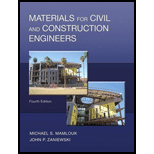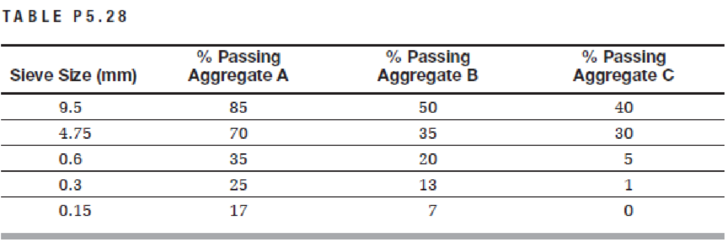
Materials for Civil and Construction Engineers (4th Edition)
4th Edition
ISBN: 9780134320533
Author: Michael S. Mamlouk, John P. Zaniewski
Publisher: PEARSON
expand_more
expand_more
format_list_bulleted
Textbook Question
Chapter 5, Problem 5.28QP
Three aggregates are to be mixed together in the following ratio:
Aggregate A: 35%
Aggregate B: 40%
Aggregate C: 25%
For each aggregate, the percent passing a set of five sieves is shown in Table P5.28.
Determine the percent passing each sieve for the blended aggregate.

Expert Solution & Answer
Want to see the full answer?
Check out a sample textbook solution
Students have asked these similar questions
8.2 only
5.6 A section of highway has the following flow-
density relationship q = 50k - 0.156k2 [with q in veh/h
and k in veh/mi]. What is the capacity of the highway
section, the speed at capacity, and the density when
the highway is at one-quarter of its capacity?
8.20 Two routes connect a suburban area and a city,
with route travel times (in minutes) given by the
expressions t₁ = 6 + 8(x₁/c₁) and t₂ = 10 + 3(x2/c2),
where the x's are expressed in thousands of vehicles
per hour and the c's are the route capacities in
thousands of vehicles per hour. Initially, the
capacities of routes 1 and 2 are 4000 and 2000 veh/h,
respectively. A reconstruction project on route 1
reduces the capacity to 3000 veh/h, but total traffic
demand is unaffected. Observational studies note a
35.28-second increase in average travel time on route
1 and a 68.5% increase in flow on route 2 after
reconstruction begins. User-equilibrium conditions
exist before and during reconstruction. If both routes
are always used, determine equilibrium flows and
travel times before and after reconstruction begins.
Chapter 5 Solutions
Materials for Civil and Construction Engineers (4th Edition)
Ch. 5 - Prob. 5.1QPCh. 5 - Discuss five different desirable characteristics...Ch. 5 - Discuss five different desirable characteristics...Ch. 5 - The shape and surface texture of aggregate...Ch. 5 - Define the following terms: a. Saturated...Ch. 5 - Three samples of fine aggregate have the...Ch. 5 - A sample of wet aggregate weighed 297.2 N. After...Ch. 5 - 46.5 kg (102.3 lb) of fine aggregate is mixed with...Ch. 5 - Samples of coarse aggregate from a stockpile are...Ch. 5 - Base course aggregate has a target dry density of...
Ch. 5 - Calculate the percent voids between aggregate...Ch. 5 - Calculate the percent voids between aggregate...Ch. 5 - Coarse aggregate is placed in a rigid bucket and...Ch. 5 - The following laboratory tests are performed on...Ch. 5 - Students in the materials lab performed the...Ch. 5 - The specific gravity and absorption test (ASTM...Ch. 5 - Prob. 5.18QPCh. 5 - Calculate the sieve analysis shown in Table P5.19...Ch. 5 - Calculate the sieve analysis shown in Table P5.20,...Ch. 5 - A sieve analysis test was performed on a sample of...Ch. 5 - A sieve analysis test was performed on a sample of...Ch. 5 - Draw a graph to show the cumulative percent...Ch. 5 - Referring to Table 5.6, plot the specification...Ch. 5 - Referring to the aggregate gradations A, B, and C...Ch. 5 - Table P5.26 shows the grain size distributions of...Ch. 5 - Table P5.27 shows the grain size distributions of...Ch. 5 - Three aggregates are to be mixed together in the...Ch. 5 - Table P5.29 shows the grain size distribution for...Ch. 5 - Laboratory specific gravity and absorption tests...Ch. 5 - Table P5.31 shows the grain size distribution for...Ch. 5 - Prob. 5.32QPCh. 5 - Laboratory specific gravity and absorption tests...Ch. 5 - Prob. 5.34QPCh. 5 - Define the fineness modulus of aggregate. What is...Ch. 5 - Calculate the fineness modulus of aggregate A in...Ch. 5 - Calculate the fineness modulus of aggregate B in...Ch. 5 - A portland cement concrete mix requires mixing...Ch. 5 - Discuss the effect of the amount of material...Ch. 5 - Aggregates from three sources having the...Ch. 5 - Aggregates from three sources having the...Ch. 5 - A contractor is considering using three stockpiles...Ch. 5 - Prob. 5.43QPCh. 5 - What are the typical deleterious substances in...Ch. 5 - Review ASTM D75 and summarize the following: a....
Knowledge Booster
Learn more about
Need a deep-dive on the concept behind this application? Look no further. Learn more about this topic, civil-engineering and related others by exploring similar questions and additional content below.Similar questions
- 8.19 Three routes connect an origin and a destination with performance functions t₁ = 8+ 0.5x1, t2 = 1 + 2x2, and t3 = 3 + 0.75x3, with the x's expressed in thousands of vehicles per hour and the 's expressed in minutes. If the peak-hour traffic demand is 3400 vehicles, determine user-equilibrium traffic flows.arrow_forward8.8 onlyarrow_forward8.4 Consider a Poisson regression model for the number of social/recreational trips generated during a peak-hour period that is estimated by (see Eq. 8.3) BZ = -0.75 +0.025(household size) + 0.008(annual household income, in thousands of dollars) + 0.10(number of nonworking household members). Suppose a household has five members (three of whom work) and an annual income of $100,000. What is the expected number of peak-hour social/recreational trips, and what is the probability that the household will not make a peak-hour social/recreational trip?arrow_forward
- 8.15 An origin-destination pair is connected by a route with a performance function t₁ = 8+ x1, and another with a function t₂ = 1 + 2x2 (with x's in thousands of vehicles per hour and t's in minutes). If the total origin-destination flow is 4000 veh/h, determine user-equilibrium and system-optimal route travel times, total travel time (in vehicle minutes), and route flows.arrow_forward8.13 Consider the situation described in Problem 8.11. If the total number of trips remains constant, determine the amount of amusement floor space that must be added to destination 2 to attract an additional 50 social/recreational trips.arrow_forward5- A basic freeway has 3 lanes in each direction and is on flat terrain. It has a jam density of 190 veh/km and a capacity of 4750 veh/h. The spot speed of 5 cars was collected at the midpoint of a 3.4 km segment of this freeway. Vehicle Speed (km/hr) 1 86 2 89 3 95 4 5 99 100 a) Calculate the space mean speed b) Calculate the free flow speed based on the given information c) A directional weekday peak-hour volume of 4640 vehicles is observed, with 1320 vehicles arriving in the most congested 15-min period. If the traffic stream has 12% large trucks and buses determine the level of service 6- What are the steps that a 4-step model used to predict travel demand on roads network consists of? Briefly describe was sort of information each step provides? 7- The bitumen is a conventional bituminous binder has a penetration index of -1 and = 65°c. T800 pen a) Determine the stiffness modulus of this bitumen if the operating conditions are as follows: temperature of 25°c and loading time of…arrow_forward
- Q) Find the location of centroid for the shaded area shown in Figure below. 20mm 42mm 23mm 30mm 30mm 10mm Xarrow_forwardQuestion 5 (Force Method). Determine the reaction at the supports. Assume A is fixed and B and C are rollers. El is constant. 3 k/ft A 10 ft B 2 k/ft 10 ft Carrow_forwardFind the collapse load (Wu) for the one-end continuous beam shown below. Wu 6 marrow_forward
- 4- As part of a highway interchange project, a ramp will be constructed to allow the vehicles exit the first highway and enter the second highway. The first highway runs north-south and the second one had a right angle to the first one (it runs east-west). Vehicles going to the north can use this exit ramp to enter the second highway as shown in the plan view in the figure below. The design speed in both highways is 100 km/hr. The stationing of the start of the horizontal curve is 40+00. a) Determine the stationing of PI and PT¶ b) The first highway has a vertical grade of +3.5% and the second highway has a grade of - 0.5%. The stationing of the beginning and the end of the crest curve are the same as the horizontal curve. What is the elevation of the end of the vertical curve (PVT) if the elevation of the start point (PVC) is 1500m c) Calculate K for the vertical curve Plan view (horizontal alignment) PT 1 N Profile view (vertical alignment) G1=0.5% PVT PC, 40+00 PVC G1=+3.5%arrow_forward10- A pavement with a thin bituminous surface is going to be constructed with a design traffic of 6*105 ESA. Laboratory testing of the subgrade and pavement materials has given the following CBR values. Design the pavement using the empirical design method. Use the and show how you got the numbers on the graph relevant graph} Subgrade CBR: 5 Granular subbase material: Upper layer CBR> 30 Lower layer CBR = 10 Granular base material CBR >100arrow_forward1- Describe the perception-reaction process in driver's decision making. What are the steps this process consists of and what tasks are included in each step? Why this process should be considered in transportation planning 3- What are the three main parts that can be included in a road cross section? Briefly describe what each part is for? Sketch a typical cross sectionarrow_forward
arrow_back_ios
SEE MORE QUESTIONS
arrow_forward_ios
Recommended textbooks for you
 Solid Waste EngineeringCivil EngineeringISBN:9781305635203Author:Worrell, William A.Publisher:Cengage Learning,
Solid Waste EngineeringCivil EngineeringISBN:9781305635203Author:Worrell, William A.Publisher:Cengage Learning, Traffic and Highway EngineeringCivil EngineeringISBN:9781305156241Author:Garber, Nicholas J.Publisher:Cengage Learning
Traffic and Highway EngineeringCivil EngineeringISBN:9781305156241Author:Garber, Nicholas J.Publisher:Cengage Learning Construction Materials, Methods and Techniques (M...Civil EngineeringISBN:9781305086272Author:William P. Spence, Eva KultermannPublisher:Cengage Learning
Construction Materials, Methods and Techniques (M...Civil EngineeringISBN:9781305086272Author:William P. Spence, Eva KultermannPublisher:Cengage Learning Fundamentals of Geotechnical Engineering (MindTap...Civil EngineeringISBN:9781305635180Author:Braja M. Das, Nagaratnam SivakuganPublisher:Cengage Learning
Fundamentals of Geotechnical Engineering (MindTap...Civil EngineeringISBN:9781305635180Author:Braja M. Das, Nagaratnam SivakuganPublisher:Cengage Learning Engineering Fundamentals: An Introduction to Engi...Civil EngineeringISBN:9781305084766Author:Saeed MoaveniPublisher:Cengage Learning
Engineering Fundamentals: An Introduction to Engi...Civil EngineeringISBN:9781305084766Author:Saeed MoaveniPublisher:Cengage Learning Materials Science And Engineering PropertiesCivil EngineeringISBN:9781111988609Author:Charles GilmorePublisher:Cengage Learning
Materials Science And Engineering PropertiesCivil EngineeringISBN:9781111988609Author:Charles GilmorePublisher:Cengage Learning

Solid Waste Engineering
Civil Engineering
ISBN:9781305635203
Author:Worrell, William A.
Publisher:Cengage Learning,

Traffic and Highway Engineering
Civil Engineering
ISBN:9781305156241
Author:Garber, Nicholas J.
Publisher:Cengage Learning

Construction Materials, Methods and Techniques (M...
Civil Engineering
ISBN:9781305086272
Author:William P. Spence, Eva Kultermann
Publisher:Cengage Learning

Fundamentals of Geotechnical Engineering (MindTap...
Civil Engineering
ISBN:9781305635180
Author:Braja M. Das, Nagaratnam Sivakugan
Publisher:Cengage Learning

Engineering Fundamentals: An Introduction to Engi...
Civil Engineering
ISBN:9781305084766
Author:Saeed Moaveni
Publisher:Cengage Learning

Materials Science And Engineering Properties
Civil Engineering
ISBN:9781111988609
Author:Charles Gilmore
Publisher:Cengage Learning
Aggregates: Properties; Author: nptelhrd;https://www.youtube.com/watch?v=49yGZYeokKM;License: Standard YouTube License, CC-BY